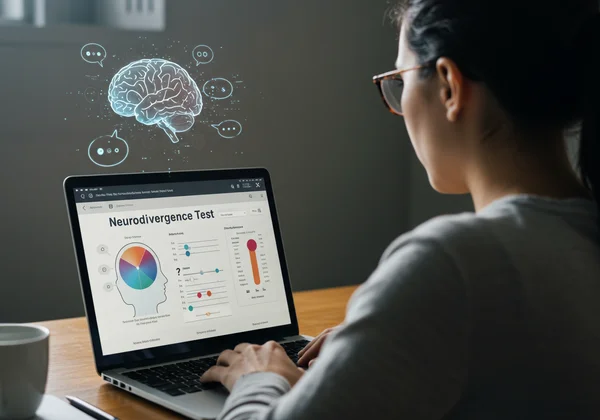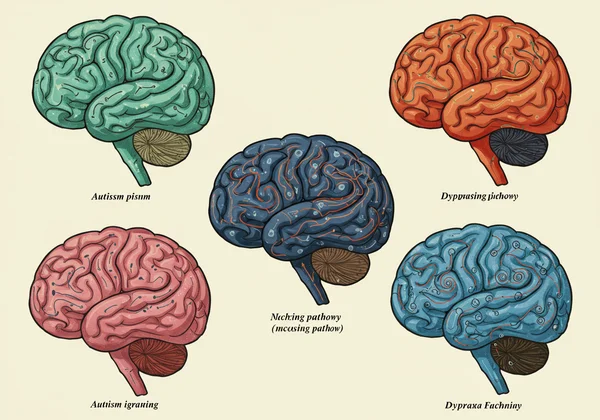理解神经多样性沟通:参加我们的免费神经多样性测试
感觉你的对话总是词不达意?你并不孤单。许多人在表达本意和他人理解之间存在隔阂,这导致了沮丧和误解。但如果这些差异并非缺点,而仅仅是处理和分享信息的不同方式呢?本指南将探索 神经多样性沟通 的多元而迷人的世界,提供见解和实用策略,以促进更有意义的联系。沟通方式可以是神经多样性的标志吗? 对许多人来说,理解这种联系是走向自我认知和建立更好关系的第一步。
了解自己独特心智的旅程通常始于一个问题。如果你对自己的沟通模式和神经特质感到好奇,一份 神经多样性测试 可以是一个很好的起点。你可以通过 免费神经多样性测试 开始探索你的特质。

什么是神经多样性沟通?了解基础知识
神经多样性沟通指的是具有神经类型差异的个体(例如自闭症、多动症或阅读障碍)处理、解读和表达信息的各种方式。它不是单一的风格,而是一个广泛的特质谱系,可能与“神经典型”对话的 不成文社交规则 显著不同。理解这一点并非为了将某种方式贴上对错的标签;而是为了认识并尊重不同大脑在社交互动中拥有不同的运作模式。一份精心设计的 神经多样性测试 可以帮助个体揭示这些不同的运作模式。
这种认知使我们能够超越评判,走向真正的好奇。它有助于解释为什么有些人喜欢直接、字面的语言,而另一些人则擅长快速切换话题的对话。通过学习这些基本知识,我们为所有人建立了同理心和更有效沟通的基础。
沟通差异的谱系
将沟通视为单一路径是具有误导性的。相反,想象它是一片拥有许多不同小径的地貌。对于神经多样性个体来说,这片地貌包括独特的对话方式。有些人可能会觉得闲聊令人筋疲力尽,更喜欢深入探讨某个特定感兴趣的话题。另一些人可能通过书写来最好地进行沟通,在那里他们可以组织自己的想法,而无需立即进行口头回应的压力。

这些并非缺点,而仅仅是变体。认识到这种 沟通谱系 有助于打破对社交互动“一刀切”的期望。它验证了那些总是觉得与传统对话规范格格不入的人的经历。
超越言语:社交线索和非语言沟通
沟通的很大一部分发生在不发一言的情况下。神经典型互动通常严重依赖于解读 微妙的社交信号 ——例如语调、面部表情和肢体语言。对于许多神经多样性人士来说,这些线索可能不那么自然而然,甚至可能以不同的方式被处理。
例如,对于自闭症人士来说,保持眼神接触可能会让他们感到不适或分心,而不是不诚实的表现。多动症个体在对话中可能会坐立不安以帮助他们集中注意力,而不是因为他们感到无聊。理解这些 非语言沟通 的差异对于避免误解和建立信任至关重要。这要求我们不仅用耳朵倾听,还要用开放且理解的心态倾听。
解读特定的神经多样性沟通风格
为了真正弥合沟通鸿沟,了解与不同神经类型相关的一些特定模式会有所帮助。虽然这些是常见的特质,但请记住,每个个体都是独一无二的。这些描述并非旨在成为僵化的分类,而是作为促进更大理解和同理心的有益参考。探索这些风格可以是自我发现中富有启发性的一部分,我们的 初步筛查工具 可以提供个性化的见解。一份 神经多样性测试 可以帮助你了解哪些特质与你产生共鸣。

自闭症沟通风格:直接、字面理解和特殊兴趣
自闭症沟通风格 通常以偏爱诚实、清晰和直接为特征。自闭症人士可能会直言不讳,避免神经典型对话中常见的委婉说法或间接表达。这不是粗鲁;这是一种优先考虑精确性和效率的沟通风格。
另一个关键特质是倾向于 字面理解 。讽刺、习语和模糊的短语可能会让人感到真正的困惑。例如,被告知“祝你成功”(直译为“祝你摔断腿”)可能会得到担忧的回应,而不是理解为祝你好运。此外,许多自闭症人士会以极大的热情和深度来谈论他们的 特殊兴趣 。与他们就这些话题进行交流通常是建立联系的有力方式。
多动症对话模式:信息倾泻、打断和超聚焦
多动症对话 可能会让人感觉像是一场能量和想法的旋风。多动症大脑通常以快速的节奏运转,导致几种独特的模式。信息倾泻 很常见,即个体出于兴奋和连接的渴望,分享大量关于他们热衷话题的信息。
看似 打断 的行为通常并非有意粗鲁。相反,这可能是大脑在想法消失前捕捉它,或者表现出对话题的参与和热情。反之,当某个话题真正引起他们的兴趣时,他们可能会进入一种 超聚焦 状态,全身心地投入到对话中,表现出强烈而坚定的注意力。
发育性协调障碍沟通:驾驭语言和非语言表达
发育性协调障碍(一种影响身体协调的状况)也会影响沟通。对于一些患有发育性协调障碍的人来说,言语中的运动技能可能存在挑战,例如控制音量、音高和语速。思绪可能会超前于他们表达的能力,导致停顿或语无伦次的句子。
这是 语言和非语言表达 的挑战,而非智力或理解力的挑战。他们可能还会发现难以解读肢体语言或使用与他们言语相符的手势。耐心并给予他们时间组织思想是支持性且成功沟通的关键。
弥合鸿沟:神经典型与神经多样性互动
对话中的摩擦往往源于一个简单的事实:不同的大脑遵循着不同的社交规则。对神经典型人士来说自然且礼貌的 方式,对神经多样性人士来说可能感到困惑或低效,反之亦然。认识到 神经典型与神经多样性 互动模式中的这些根本差异,是建立理解之桥的第一步。
这并非要求一方完全采纳另一方的风格。它是关于培养相互尊重和发展一种共同语言。这个过程要求双方都保持灵活性、好奇心,并愿意走出自己的对话舒适区。如果你不确定自己在这种互动模式中属于哪一类,你可以在我们的网站上 探索你的特质 。我们的 神经典型与神经多样性测试 旨在为这些问题提供清晰的答案。
常见误解及如何应对
当不同的沟通风格相遇时,误解几乎是不可避免的。自闭症人士的直接评论可能会被神经典型人士认为是生硬的。神经典型人士使用的微妙暗示可能会被字面思考的人完全忽视。多动症患者的跳跃式话题可能会被视为不感兴趣,而非积极参与的标志。
要应对这些情况,关键在于就沟通本身进行沟通。与其做出假设,不如寻求澄清。你可以说:“你那样说的时候,是这个意思吗……?”或者“我说话比较直接,所以如果我让你觉得生硬,请告诉我。”这种元沟通为每个人创造了一个更安全的空间。
同理心和假定积极意图的作用
弥合任何沟通鸿沟最强大的工具也许是 假定积极意图 。这意味着从一开始就假设对方并非故意制造困难、粗鲁或不屑一顾。相反,假设他们正在以对他们来说最自然和真实的方式进行沟通。
这种心态将焦点从指责转向好奇。与其想“他们为什么如此唐突?”,你可能会思考“他们是不是更喜欢直接的沟通方式?”这种虽小却深远的转变鼓励了 同理心 ,并将潜在的冲突转化为连接和学习的机会。

更有效对话的实用策略
理解理论很重要,但真正的改变发生在实践中。无论你认为自己是神经多样性人士、神经典型人士,还是仍在探索自己的思维,你都可以采取具体步骤,让你的对话更具包容性和有效性。这些策略有助于减少误解,并在你生活的各个领域建立更牢固、更真实的联系。如何进行神经多样性测试? 第一步可以像在线筛查一样简单。
你准备好了解更多关于你的个人沟通风格了吗?我们的 免费神经多样性测试 是一个简单的探索起点。 参加测试 以获得宝贵的见解。
神经多样性个体的建议:自我倡导和清晰度
对于神经多样性个体来说,自我倡导 是一个强大的工具。这意味着了解你的沟通需求,并有能力表达它们。完全可以说:“我有时会非常按字面意思理解话语,你能更直接一点吗?”或者“我发现眼神交流很困难,但请知道我正在倾听并投入其中。”
练习 清晰度 也会有所帮助。如果你知道自己兴奋时容易滔滔不绝,可以在开口前说:“我对这个话题非常热情,所以如果我一下子分享很多,请耐心听我讲!”不带歉意地接受自己的沟通风格,能为他人提供如何最好地与你互动的清晰路线图。
神经典型个体的建议:积极倾听和澄清问题
对于神经典型个体来说,目标是成为一个更灵活、更留心的沟通伙伴。通过完全专注于对方所说的话,而不是计划你的回应,来练习 积极倾听 。关注他们的言语,而不仅仅是你对他们语气或肢体语言的解读。
使用 澄清性问题 也非常有效。与其假设你理解了,不如直接提问。简单的问题,如“你能多告诉我一些吗?”或“这对你来说最重要的部分是什么?”表明你很投入,并且真心想了解他们的观点,从而创造一个尊重和认可的环境。
创建包容性沟通环境
最终,目标是营造包容所有沟通风格的环境。在工作场所、学校和家庭中,这意味着建立 包容性沟通 的规范。这可能包括提供多种参与会议的方式(例如,发言、聊天或书面笔记),明确表达期望,并鼓励就沟通需求进行开放对话。
当我们不再将一种沟通风格视为默认标准,并开始庆祝人类表达的多样性时,我们就能建立更强大的团队、更深厚的友谊和更具同理心的社区。这一切都始于学习和适应的意愿。
拥抱神经多样性连接
拥抱多元化的沟通风格不仅仅是一种善举;它更是对人类神经系统的丰富多彩的认可。当我们超越假设,学会欣赏直接、充满激情的“信息倾泻”以及处理社交线索的不同方式时,我们就能丰富我们的连接,增强我们的社区。通过理解这些差异并采纳实用策略,我们都能为建设一个更具包容性的世界做出贡献,让每个声音都被听到、被理解和被珍视。
自我发现的旅程是深刻的个人体验,并赋予人力量。要开始探索你自己的沟通风格和其他特质,你今天就可以通过参加我们免费、保密的在线 神经多样性测试 来 发现你的个人档案 。
关于神经多样性沟通的常见问题
常见的神经多样性沟通特质有哪些?
常见的特质差异很大,但可能包括偏爱直接和字面语言,深入探讨特定话题(特殊兴趣),难以解读非语言线索,信息倾泻,以及对话中话题转移。重要的是要记住这些都属于一个谱系,并非所有神经多样性人士都会具有相同的特质。
神经典型与神经多样性沟通有何不同?
主要区别通常在于不成文的规则。神经典型沟通常依赖于弦外之音、间接语言和对社交线索的共同理解。神经多样性沟通可能优先考虑清晰度、逻辑性和明确信息,而非社交细微差别。两者本身无优劣之分;它们只是不同的系统。了解自己的风格是第一步,你可以通过我们的 神经多样性筛查 开始。这份 神经多样性测试 并非诊断,而是一种探索工具。
沟通方式可以是神经多样性的标志吗?
是的,与常规不同的、持续存在的独特沟通模式,可能是神经多样性的强烈指标。如果你一直感到被误解,或者觉得自己在社交规则上“没领会到”,这可能表明你的大脑处理社交信息的方式不同。进行 我是否神经多样性测试 对许多人来说可能是一种验证性的体验。
神经多样性沟通的优势有哪些?
神经多样性沟通具有许多优势!这些优势可能包括令人难以置信的诚实和透明、不装腔作势、在感兴趣领域拥有深厚知识、独特而富有创造性的视角,以及能够高度专注于解决问题的能力。在重视真实性和创新的关系和工作场所中,这些特质是无价的。